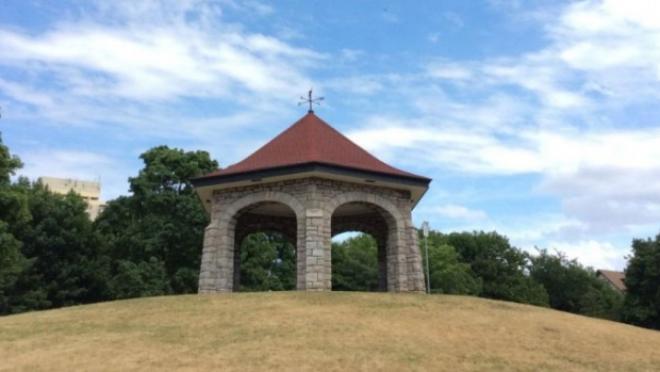CBC NEWS OTTAWA, By Jennifer Chevalier
UPDATE | May 11: Lowertown's Macdonald Gardens is on course to become an official heritage space after Ottawa's built heritage sub-committee voted to grant it the special recognition.
The park, bordered by Tormey, Cobourg, Heney and Wurtemburg streets, was designed in 1914 by Frederick G. Todd, known as Canada's first landscape architect, on the site of a former cemetery.
Architect Barry Padolsky, vice-chair of the sub-committee, said it's time the park was properly recognized.
"Todd was one of the founders of the landscape architecture movement in Canada. He was involved in the first master plan for the national capital, so he's a very significant character in urban design history," Padolsky said.
Lowertown Community Association co-chair Nancy Miller-Chenier was pleased with Thursday's decision.
"It's a fabulous gift to the community," she said.
The original cemetery was closed in the 1870's and the human remains were moved to the nearby Beechwood and Notre Dame cemeteries. A newspaper story from the 1930's describes how the removal plan was far from thorough though, leading to the occasional shocking find.
Padolsky said he hoped the designation would remind people about Lowertown's vibrant history. He told the sub-committee Lowertown East could have been a designated heritage district had slum clearances ordered by the city, province and federal governments in the 1970s not destroyed the neighbourhood.
"As we approve this [park], let's just remind ourselves that we in the public sector have also done our bit to erode the heritage character of Lowertown," Padolsky said.
Padolsky is calling on council to now turn its attention to Anglesea Square, the area made famous by the 1984 children's novel Angel Square by Brian K. Doyle.
Heritage Ottawa enthusiastically supports the designation of MacDonald Gardens Park, a significant treasure in Ottawa’s landscape. Congratulations to all involved in preparing this proposed designation.
_______________________________
Original Story, May 10, 2017
MacDonald Gardens Could Become Heritage Park; Built-heritage subcommittee to decide Thursday on designation
One of Ottawa's oldest city parks could become a protected heritage space if councillors approve a plan to designate the Lowertown park under the Ontario Heritage Act.
The Macdonald Gardens Park at Cobourg Street was built in 1914, on the site of a former cemetery.
A city heritage staff report makes the case for the heritage designation, arguing the park has architectural, historical and contextual significance.
Council's built heritage subcommittee will discuss the issue at its meeting Thursday morning.
Park Was Former Cemetery
Although most of the remains were moved over time after the cemetery was closed in the 1870s, there are reports that unclaimed remains stayed at the park — and are still buried there. (Oddly, the city's report does not mention this fact, even though a 1936 local newspaper story quoted a man who saw a skull roll down his street by the park, when some landscaping work was being undertaken.)
The park was designed by Frederick G. Todd, who the Canadian Encyclopedia calls "the first truly resident landscape architect in Canada," one of a small handful of landscape architects and planners committed to designing greenspace in urban settings in the first half of the 20th century in Canada.
Designer major figure in early landscape architecture
The Massachusetts-born Todd apprenticed under Frederick Law Olmsted, of New York's Central Park fame, and designed a number of landscaped parks in major centres across Canada.
Todd designed Shaughnessy Park in Vancouver in 1907, and made ongoing contributions to the landscape projects in Montreal, where he lived from 1900. Todd created designs for St. Helen's Island Parks, Memorial Cemetery and The Garden of the Way of the Cross — associated with St. Joseph's Oratory — and restored Mount Royal Mountain.
Todd was commissioned by the forerunner to the National Capital Commission for a major plan for the city, which was never carried out. But Todd's plans for Macdonald Gardens Park were.
There have been some changes to the park over the years, but the park's role as a tranquil space for "passive recreation" with paths, open spaces and native trees remains to this day, according the city heritage staff's report.
And the so-called "summer house", a stone hexagonal gazebo which sits on a small hill, is a landmark from nearby Cobourg, Tormey, Heney and Wurtemburg streets.
Councillor in favour
Area Coun. Mathieu Fleury is supportive of the plan for heritage designation for the park, which he characterizes as greatly contributing "to the green urban infrastructure in Lowertown."
In his comments included in the report, Fleury also pointed out that it would be appropriate to protect and recognize Macdonald Gardens ahead of the 150th celebrations considering the park was named after Sir John A. Macdonald.
Heritage Ottawa enthusiastically supports the designation of MacDonald Gardens Park, a significant treasure in Ottawa’s landscape. Congratulations to all involved in preparing this proposed designation.
